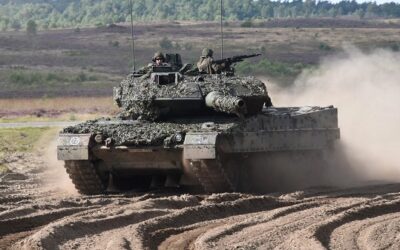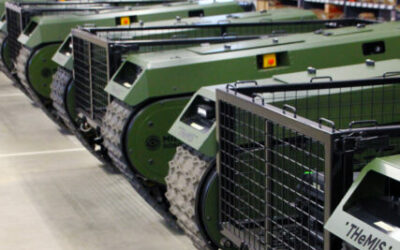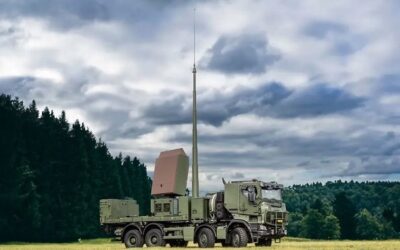Air-Launched UAS Programme Enters Phase 3
The US Defense Advanced Research Projects Agency (DARPA) GREMLINS programme envisions launching groups of UAS (GREMLINS) from existing large aircraft such as bombers or transport aircraft – as well as from fighters and other platforms – while those aircraft are out of range of adversary defences. When they complete their mission, a C-130 transport aircraft will retrieve them in the air and carry them home, where ground crews will prepare them for their next use within 24 hours.
This April, the programme moved to Phase 3 which, according to the agency, includes developing one full-scale technology demonstration system and conducting flight demonstrations involving airborne launch and recovery of multiple GREMLINS. Dynetics is the prime contractor for this phase and Tim Keeter, the company’s programme manager, updated MON on his industry-led team’s fast-moving efforts over the last seven months to support the government customer. “DARPA’s and Dynetics’ vision for GREMLINS has not changed since Phase 1. GREMLINS is an affordable, airborne, open-architecture system that can be used as a node to conduct collaborative, coherent operations that distribute a variety of effects. The attritable and air-launch/air-recoverable nature of GREMLINS further enables the warfighter to extend the reach of the air order of battle in contested/denied environments, while preserving and protecting high-value, exquisite assets. The result is a more capable, less costly, heterogeneous approach to achieving lethality.”
This early February, Dynetics conducted a flight test of its docking system, onboard and ground-based control stations, and data links. The towed docking device, augmented now with an active control system, demonstrated the ability to improve overall system performance for airborne recovery, even in turns. The corporate programme manager noted, “You really want the docking system to be as still as possible once it’s deployed in flight to improve docking performance for the GREMLINS Air Vehicle. The active control does a great job quickly recovering from disturbances due to turbulence and C-130 motion.”
In March, the Dynetics team reached another milestone by accomplishing the first flight of the GREMLINS Air Vehicle (GAV) avionics. These were installed onboard the Calspan Variable Stability System (VSS) LEARJET, which was also configured to mimic the performance characteristics of the GAV. Once the LEARJET entered the test range, the GREMLINS control station took over control of the aircraft, directing it to fly multiple race-tracks and manoeuvres. Handovers occurred between multiple in-flight and ground-based control stations to demonstrate the flexibility and redundancy of the integrated system, and safety modes for the GAV were tested and confirmed.
“The Calspan VSS is truly an awesome capability, allowing us to fully exercise the integrated avionics, control station, and data links prior to the first GAV flight,” Keeter pointed out. Currently, the Dynetics Team has completed full functional ground testing for the GAV, which awaits first flight. “We are ready to begin flight testing of our integrated GREMLINS system. We will perform a checkout flight of our GAV followed by early recovery attempts […] Once we achieve our first recovery, we will build up to our final demonstration of attempting to recover four GAVs in under 30 minutes. Our plan was originally scheduled to begin this flight testing phase this September, but the California earthquake this summer has caused some delays while the range recovers and conducts repairs,” he reported.
Dynetics has an eclectic industry team to bring Phase 3 to successful completion: Kratos Unmanned Aerial Systems (KUAS) leads manufacturing of the composite airframe and fabrication, assembly, integration and test of each GAV; Sierra Nevada Corporation (SNC) provides the GREMLINS Autonomous Docking System (GADS) for precision navigation, motion compensation, guidance and control during recovery; Williams International provides the F107 turbojet engine, a fielded, robust and proven turbofan engine; Moog provides the control actuation system; Airborne Systems is adapting an existing parachute and airbag subsystem to prevent damage to the GAV during ground recoveries in early flight tests; Systima provides the DRAGON SPEAR C-130 pylon and launch system; Applied Systems Engineering (ASEI) provides the GAV Flight Computer; SNC/Kutta provides the multi-vehicle control service for the Operator Control Station.
Dynetics’ successful GREMLINS accomplishments will support its business development efforts for other US or allied defence programmes. Mr Keeter pointed out that in executing the GREMLINS programme, “Dynetics has furthered matured its ability to provide increasingly complex and relevant technologies within the context of rapid development programs that can quickly transition to operational users. Working with our exceptional industry partners has both strengthened existing business relationships and forged new, strategic ones – our existing GREMLINS team is well-positioned to tackle new technology programs together as well as mature GREMLINS to an operational capability […] While we are not yet ready to reveal details [as to what comes next], we expect much more to come after the successful completion of Phase 3.”
Marty Kauchak

























